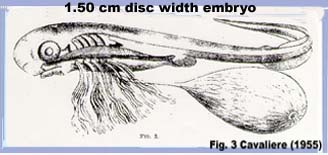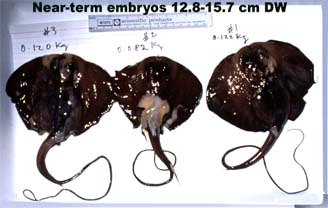




| 
|
| Eggs are ovulated by ovary and encapuslated in the shell gland. The eggcase shown here, with infertile eggs, was aborted. Normally, the eggcase is retained in the uterus and the embryos will hatch at an early stage of development. | The eggs are fairly small (~ 1-2 g); far too small to produce embryos which weigh 150-200 g at birth. This 1.50 cm disc width embryo still has a fairly large yolk-sac but it is probably also absorbing "mother milk" through the gill filaments. All three views are shown here. Thanks to Fulvio Garibaldi for sending a copy of Cavaliere, A. 1955. Embrione di Trygon violacea BP. Boll. Pesca e Idrobiol. 9:197-200. |

| 
|
| This 5 cm disc width embryo has used up all the reserves in the yolk-sac and was feeding on the rich "mother milk" (13.2% organic) produced by the trophonemata of the uterus wall. It has no pigmentation yet and was aborted for unknown reasons. | These near-term embryos were aborted for unknown reasons over one year after the mother was captured in the wild. There were only female pelagic stingrays in the tank and it suggests sperm storage because the gestation period is only 2-3 months long (diapause or parthenogenesis are other possibilities). Parthenogenesis (= asexual reproduction) was reported for bonnethead sharks by Chapman et al. (2007). |